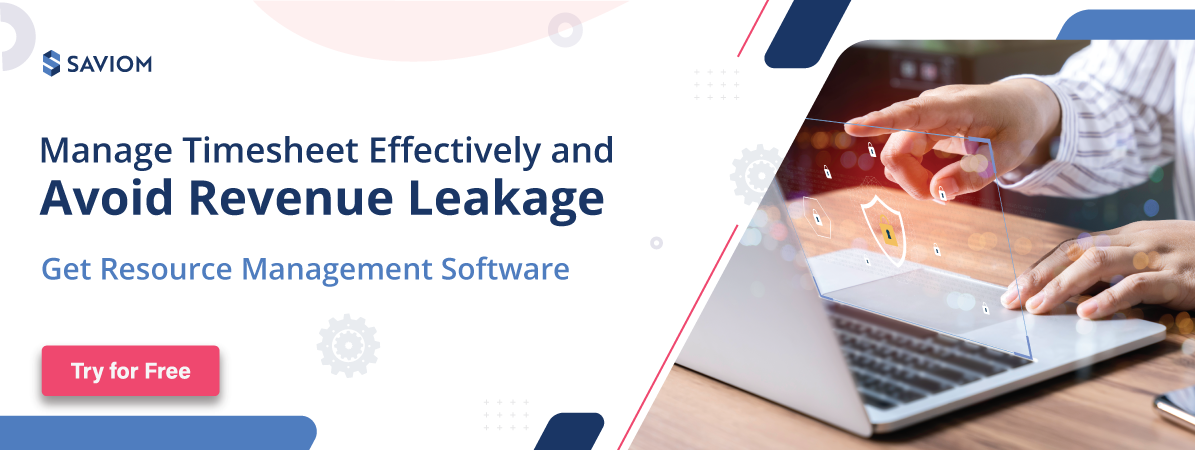What do professional services firms thrive upon? Employees’ billable hours.
But, how can they record these details with accuracy? The answer is timesheet software.
Professional services organizations have a particular business model that relies on accurate billing of the work done for the clients. They need to track the hours spent by the employees to regulate their billable hours, generate accurate invoices, and process payrolls.
Therefore, it’s imperative for professional services firms to implement a real-time tracking system that accurately logs every minute spent on tasks. It’s one of the most significant ways to track employees’ utilization, analyze their actual time spent on tasks against forecasted to align future allocations to reality, and ensure precision facilitates timely invoicing to avoid revenue leakage.
This blog highlights the importance of timesheet maintenance for consultancy firms and some tips to manage them.
Why do professional services firms need Timesheets?
In the professional services industry, most projects are short-duration, and clients are billed hourly. Thus, the managers need to keep track of every resource and the projects they are working on. It helps streamline the employees’ payrolls, provide accurate client invoicing, thereby improving the organization’s efficiency and profitability.
Currently, many firms rely on manual record books or excel-based timesheets to log these details. However, they are cumbersome and prone to manual error. Thus, it’s time for businesses to look for a more innovative, time-saving, accurate solution, and helps maintain the database on one platform. This is where the timesheet software can prove beneficial.
Below are some of the reasons why they can be used in this scenario:
- Managers can review the timesheets in real-time with accurate insights and send them further for payroll processing almost immediately. Thus, it minimizes the latency and any chances of time theft.
- Moreover, resources won’t have to send endless email trails for timesheet approvals. A real-time software sends it directly to the reporting managers once submitted. They can authorize the sheets from any location.
- Modern time tracking can be integrated with resource management software and be used to maximize the resources’ productive utilization. Thus, managers can also course-correct instances of over/underutilization.
- This tool also negates the need to maintain multiple records or databases across departments. It breaks the silos and maintains records of the enterprise-wide resources (remote and in-office) on one platform.
- Similar to integration with the resource management tool, a timesheet can also be embedded into different software, and its data can be used to procure insightful reports on various metrics.
- In some advanced solutions, resources can also log in and start the timer for specific tasks. Following this, the software will automatically record the hours until the resource stops the timer. It helps in reducing the time employees put in filling the timesheets manually and also enhances precision.

In a nutshell, real-time timesheet tracking can streamline employees’ attendance while also helping the managers regulate invoice and payroll management processes. Moreover, its utility expands in different horizons, and managers can also use the data recorded to enhance the resources’ billability, utilization, productivity, etc.
Timesheets vs. Attendance software
There are various ways to track your employees’ attendance and day-to-day activities. Selecting the right software for your needs can be daunting, and thus to simplify it, we have narrowed it down to two specific tools. They are:
- Attendance tracking software.
- Timesheet/time tracking software.
However, before selecting any of these tools, you must understand the difference and determine the best one for your business.
Attendance tracking software
This tool is based on the clock in/out process. Employees need to manually clock in at the start of their schedules and then clock out when their day is over. It provides information on the number of hours the employees have put in. Based on this, the management can understand if they are logging in late or logging out early.
In today’s world, organizations use biometric scanners or facial recognition systems to track attendance. But the information gathered is the same as traditional attendance systems. These tools are primarily used by retail outlets, food service companies, etc. However, attendance tools may not be fruitful enough for professional services firms as they cannot track project/task durations or strategic/ billable activities.
Now, let’s understand the time tracking software and how it can be a better option for the professional services industry.
Timesheets/time tracking software
A time tracking software or timesheet allows managers to enter the project tasks for the employees, and following that, the resources can log the time spent against each task or project. Along with that, the timesheet also has a comment box where they can enter additional details about the task for better clarity and transparency.
As stated earlier, the integrability feature makes it an excellent tool for monitoring project activities and resources’ productivity. For example, the employees’ data filled in their timesheets can be used by a resource management tool or a PSA tool to generate other metric reports such as utilization or forecast vs. actual. Thus, managers can compare it with the allocated hours and understand how long tasks should ideally take and how long the employees are taking. Moreover, it can also help answer questions like:
- Are the resources being optimally utilized?
- Are the projects behind schedule or going over budget?
In addition to these features, an invoice generating or PSA software can also leverage the timesheet data to create invoices by factoring in the employees’ hourly charge-out rates. Thus, you can make invoices with speed and accuracy. These features and benefits are discussed in detail in the later sections.
Therefore, with all being said, it’s evident that time tracking software is a more feasible option for professional service firms than a simple attendance tracker.
What are the different types of Timesheets?
A timesheet is a record tracker that allows employees to log in the work they have done alongside each project with its duration against their capacity. Thus, they are used to record time spent on specific tasks. Also, there are various methods to record timesheets, such as on paper, using excel sheets, or through a dedicated software.
There are three types of timesheets based on the purpose they serve, they are:
Payroll timesheets
These timesheets help in tracking the number of hours an employee has worked to streamline payrolls. Moreover, they also record leaves, vacations, or any other information needed to precisely calculate the paid and unpaid leaves. Employees need to enter their day-to-day work information, following which the managers will approve and send it forward for salary processing.
Online timesheets
Online timesheets are the digital versions of traditional payroll timesheets. However, these timesheets can be integrated with the payroll software and used for real-time time tracking. Moreover, employees can enter data in online timesheets from anywhere and through any device.
Employee timesheets
Employee timesheets are used for non-exempt employees who work on an hourly basis. These timesheets are used to track their hours and also the overtime so that employers can provide fair wages.
Now that you know what a timesheet is and the categories, let’s understand why the traditional timesheets templates are a thing of the past.
Why is the Traditional Timesheet Template obsolete in the 2020s?
Traditional timesheet templates are error-prone and need to be checked and reviewed several times before they can be used for payroll configuration. In organizations where these types of timesheets are used, managers, the HR team, and the finance department have to spend a lot of time processing the records. Thus, it leads to chaos and confusion.
Here is a rundown of the reasons why traditional timesheet templates are not the ideal solution for tracking employees’ hours:
- These timesheets lack in providing an accurate record of employees’ working hours. Since they are manual, in some cases, employees may indulge in malpractices such as time thefts.
- Management has to spend a lot of their time reviewing and approving the records.
- Since they are based on manual processing, filling up these timesheets can hamper the productivity of employees.
- There are no mechanisms to check the authority of these timesheets. Employees may put misleading or wrong data regarding arrival and departure from the office.
- Since they are manual and not standardized, these timesheets may be subject to bias from the HR department or management.
- As the invoicing will be done manually, it may be subject to inaccuracy, causing revenue leakage for the company or a bad reputation with the clients.
- Traditional timesheets create silos of data, as every department maintains its own template. Thus, there is no standardization of policies across the organization.
Benefits of Timesheet software in professional services firms
Professional services firms have a large resource pool. Moreover, these employees are scattered among different locations and may be working for several clients. That’s why a centralized timesheet solution can be an excellent addition for such organizations. It can help keep the timesheets up to date without human intervention. Thus, employees can spend their time on the projects and tasks that matter. Moreover, the upper management can access any information at any time to implement payroll functionalities.
Here is a detailed description of the advantages of a real-time time tracking solution for consultancy firms:
Provides real-time insights into resource utilization
The timesheets can either be used as a standalone solution or come as an add-on in different software and tools. In either case, it can be integrated into other tools, and the data can be used to infer actionable insights. Taking the previous example, a resource management software can utilize the data and curate utilization and forecast vs. actual reports. Using business intelligence, it can be visualized in the form of color-coded heatmaps that showcase the real-time utilization rates of employees.
For example, it shows 80-100% utilization as green depicting maximal or optimal utilization, 50-80% is shown as yellow, and anything below that is red. Based on that, managers can understand if the resources are optimally utilized or not. Thus, they can take necessary actions to minimize the under/over utilization symptoms.
Facilitates automated invoicing and payroll processing
As stated earlier, with the help of this time tracking solution, managers can review the data filled in by the employees quickly. The tool gives them a clear picture of the billable hours put in by the employees. Following this, they can approve the timesheets and send them forward for invoice processing. Thus, it helps ensure accurate invoicing where there is no billable loss of any kind.
Also, since the tool can track work hours, leaves, accruals, and adjustments, management can have direct visibility into how team members are spending their time and their productivity. Thus, it helps streamline and standardize payroll processing. Since everything is well-documented and devoid of human errors, there are no chances of conflicts or biases.
Procures forecast vs. actual reports
Forecast vs. Actual reports are helpful to understand the project’s progress and if it’s in line with the initial plan. Thus, managers can understand the variance between the planned (expected) and the actual values using these reports. If yes, they can take corrective measures ahead of time to meet the deadline, control the project’s lifecycle, and avoid billable loss. Besides, they can also form a course-corrective plan to cater to the deviation in employees’ utilization.
If employees spend more time than predicted on specific tasks, managers can investigate the cause for the excessive time spent. Following this, they can adjust the estimates if needed and communicate the same to the employees. These forewarned reports also help managers in improving the project plan for future projects.
Standardizes policies and ensures compliance
Using a standard tool to track employees’ activities across the enterprise creates traditional practices. Every department is compelled to follow the same rules and guidelines while filling in their timesheets. This ensures that every employee is treated fairly and there are no biases for payroll or invoice processing. In addition, the time tracking systems can be easily integrated with the internal knowledge management solution.
Therefore, the timesheets can be programmed as per the company policies and guidelines. It helps the employees understand how to fill and submit the timesheets on time and adhere to the organizational rules and regulations. Moreover, if they have any questions regarding the company’s laws and policies, then the software can provide answers to those questions as well. Lastly, it also helps in minimizing the chances of time thefts and ensures ethical practices.
Reduces administrative overhead
Since everything is streamlined via the tool, it minimizes excess admin work like payroll regulation, invoicing, etc. With pre-scheduled reminders and background entries, employers can submit their timesheets on time. It helps in speeding up the reporting, approval process, and reconciliation.
Besides, timesheets also help in enhancing employees’ work efficiency and productivity. As employees get relieved from doing specific mundane tasks, they can focus on the tasks that matter. Moreover, organizations can relieve the excessive admin workforce or indulge them in strategic activities to reduce the overall administrative overhead. Thus, timesheets are also beneficial for minimizing costs.
In conclusion, we have added some proven tips you can leverage to manage these timesheets seamlessly.
Conclusion- Tips to manage timesheets
Managing timesheets require standardization and following a routine. Here are some tips for managing timesheets properly:
- First, move from traditional timesheets to a dedicated software.
- Integrate the modern timesheet solution with the company’s invoicing and payroll systems and other relevant software.
- Include the company policies and timings guidelines in the solution.
- Ensure that all the employees fill their data into the timesheet regularly.
- Ascertain that the managers approve the timesheets on time before the month-end so that payrolls can be processed.
So, are you planning to switch to a real-time time tracking system yet?
The Glossary
SAVIOM Solution
SAVIOM has over 20 years of experience helping multinational clients manage their resources efficiently and effectively. With over 20 years of experience, this Australian-based MNC has a global presence across 50 countries and has helped 100+ clients meet their specific business goals. Saviom also provides tools for project portfolio management, professional service automation, and workforce planning software. So, SAVIOM can help your business to establish an efficient system geared towards your specific business challenges.
















